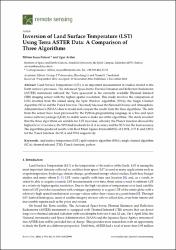| dc.contributor.author | Ndossi, Milton İsaya | |
| dc.contributor.author | Avdan, Uğur | |
| dc.date.accessioned | 2019-10-23T17:56:16Z | |
| dc.date.available | 2019-10-23T17:56:16Z | |
| dc.date.issued | 2016 | |
| dc.identifier.issn | 2072-4292 | |
| dc.identifier.uri | https://dx.doi.org/10.3390/rs8120993 | |
| dc.identifier.uri | https://hdl.handle.net/11421/22900 | |
| dc.description | WOS: 000392489400022 | en_US |
| dc.description.abstract | Land Surface Temperature (LST) is an important measurement in studies related to the Earth surface's processes. The Advanced Space-borne Thermal Emission and Reflection Radiometer (ASTER) instrument onboard the Terra spacecraft is the currently available Thermal Infrared (TIR) imaging sensor with the highest spatial resolution. This study involves the comparison of LSTs inverted from the sensor using the Split Window Algorithm (SWA), the Single Channel Algorithm (SCA) and the Planck function. This study has used the National Oceanic and Atmospheric Administration's (NOAA) data to model and compare the results from the three algorithms. The data from the sensor have been processed by the Python programming language in a free and open source software package (QGIS) to enable users to make use of the algorithms. The study revealed that the three algorithms are suitable for LST inversion, whereby the Planck function showed the highest level of accuracy, the SWA had moderate level of accuracy and the SCA had the least accuracy. The algorithms produced results with Root Mean Square Errors (RMSE) of 2.29 K, 3.77 K and 2.88 K for the Planck function, the SCA and SWA respectively. | en_US |
| dc.description.sponsorship | Anadolu University Scientific Research Projects Commission [1601F031]; Anadolu University | en_US |
| dc.description.sponsorship | This study was supported by Anadolu University Scientific Research Projects Commission under the grant number 1601F031. We sincerely appreciate the research funding which was provided by Anadolu University for this article. The authors would like to express their high gratitude to the ASTER science team and the National Oceanic and Atmospheric Administration (NOAA) for providing SURFRAD ground data free of charge. Special thanks go to the United States Geological Survey (USGS) for providing the image archives. Finally, the authors would like to thank the QGIS development team for creating an API which allows users to make use of the QGIS software for Python Geoprocessing. | en_US |
| dc.language.iso | eng | en_US |
| dc.publisher | MDPI AG | en_US |
| dc.relation.isversionof | 10.3390/rs8120993 | en_US |
| dc.rights | info:eu-repo/semantics/openAccess | en_US |
| dc.subject | Land Surface Temperature (Lst) | en_US |
| dc.subject | Split Window Algorithm (Swa) | en_US |
| dc.subject | Single Channel Algorithm (Sca) | en_US |
| dc.subject | Thermal Infrared (Tir) | en_US |
| dc.subject | Planck Function | en_US |
| dc.subject | Python | en_US |
| dc.title | Inversion of Land Surface Temperature (LST) Using Terra ASTER Data: A Comparison of Three Algorithms | en_US |
| dc.type | article | en_US |
| dc.relation.journal | Remote Sensing | en_US |
| dc.contributor.department | Anadolu Üniversitesi, Yer ve Uzay Bilimleri Enstitüsü | en_US |
| dc.identifier.volume | 8 | en_US |
| dc.identifier.issue | 12 | en_US |
| dc.relation.publicationcategory | Makale - Uluslararası Hakemli Dergi - Kurum Öğretim Elemanı | en_US] |
| dc.contributor.institutionauthor | Avdan, Uğur | |


















